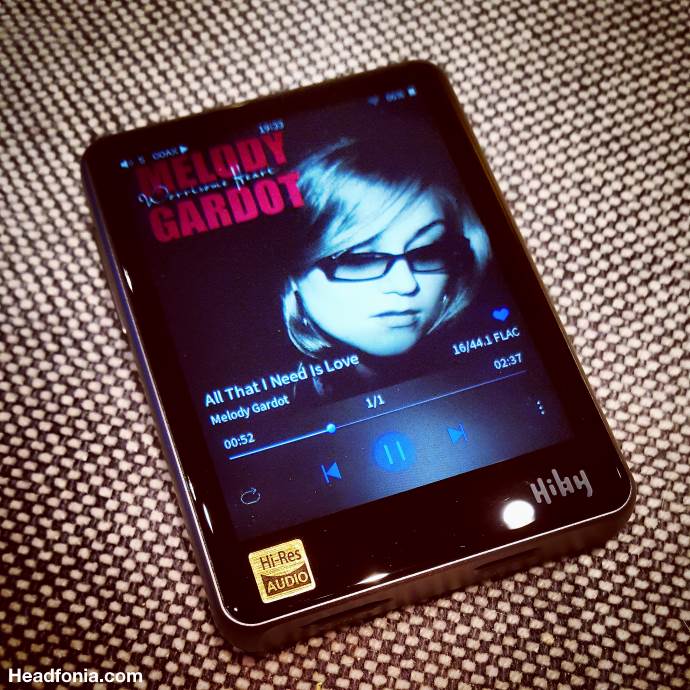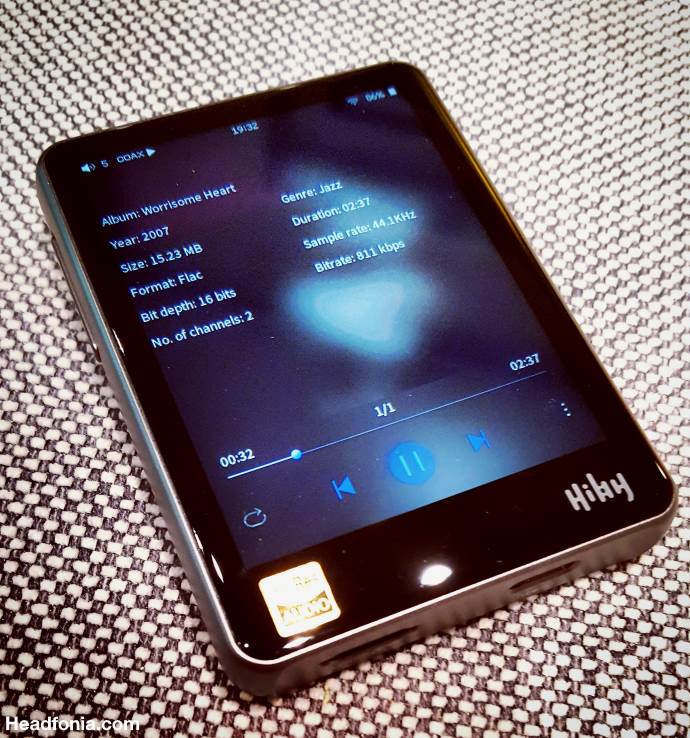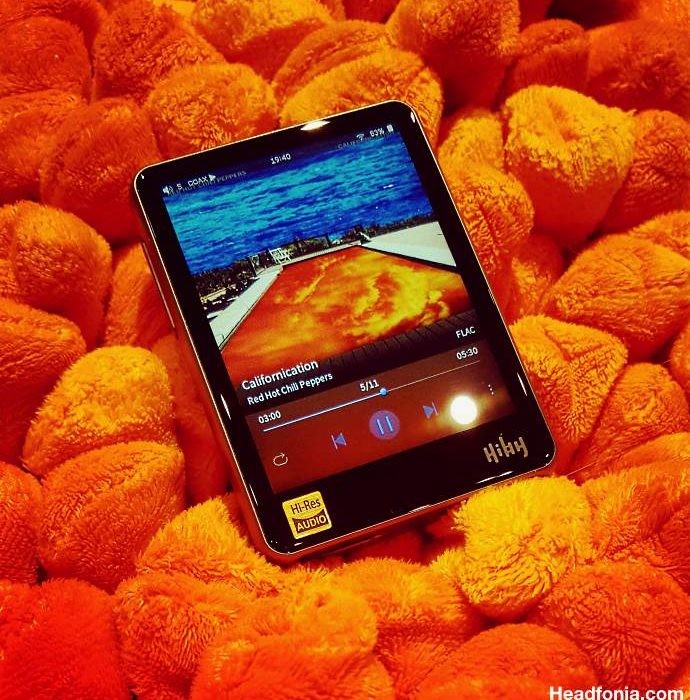Navigation & menus
The main navigation bar the is the top horizontal one and it has 5 menu items:
- Settings
- Files
- My music
- Tidal
- Now playing
Both the main menu as well as the Settings menu can also be accessed by swiping from left to right on the screen. The Settings options are: Update Database/Import Music via Wifi/MSEB/EQ/Wireless settings/Play settings/System settings and About.
The “Files” menu has a second horizontal menu with the following options: All/Files/Albums/genres. In the Artist menu you can switch to the Artist/album menu by clicking the on screen button located in the top right. The “My Music” menu has only 3 options: My favorites/Recently played/Playlists. The “Tidal” menu has both a horizontal and vertical menu and you can do everything within Tidal as you’re used to. As said the download to MicroSD card option will be available later. The “now playing” tab brings you to the song that’s playing. In that screen you can tap the screen to switch between the album art and the lyrics.
Besides all these menus there are two hidden menus as well. By swiping from the top down you get a menu with the following options: Wifi/Bluetooth/DLNA/Airplay/Gain/Replay gain/Coax and line out. When you swipe from the bottom up you get a quick menu with the following options: Screen brightness/volume/Hiby Music control (play/pause/next/previous).
In the system and play settings you have the usual settings you can find in any decent DAP. As said, this menu structure might be different in the final firmware you will get, but this gives you a good idea of everything the player is and will be capable of doing.
R3 Sound
Even from the very first notes it was obvious that the Hiby R3 is made to enjoy your music. With that I mean that it sounds good and that the musicality level is very high. This isn’t the kind of DAP that gives you every last bit of detail such as the SP1000, this is a smoother kind of sound where the enjoyment factor is the more important than the precision and neutrality factor. That doesn’t mean the R3 doesn’t produce a detailed sound, but it does mean it’s a warmer kind of sound, presented in a smooth way. Neutrality is not what you’ll find in the R3, but that’s perfectly fine, it wasn’t intended to sound like that either.

Hiby R3
We don’t really know the architecture of the R3 just yet, but after going back and forth between the single ended and the balanced output, we can only decide the difference in sound signature really isn’t as different as compared to say with Cayin or Astell&Kern. They sound very much alike but you do get more power via the balanced output. I won’t make a difference in the description of how it sounds as a result of that.
Looking at the price the R3 is going for and comparing it to other DAPs in the market, it sound stage is perfectly in line with what can be expected. No it’s not the widest and certainly not the deepest but it isn’t exactly small either. You get a nicely spacious presentation with good separation and because of that it doesn’t sound intimate or closed. Compared to the SP1000? Well that’s another story, just to say there of course is better.
You get a fairly clean sound and the clarity is mostly to be found in the upper mids and treble section. Both the bass and lower mid-section have more than neutral body and they come with a good amount of warmth and smoothness. The outcome is a high musicality factor and really enjoyable sound. Bass has good body and impact and it reaches down pretty low but it isn’t the most detailed or layered kind of bass. I didn’t really expected it to be so either, the R3 is pretty forgiving and easy on the ear. The lower mids and mid mids (still following?) share the same characteristics of the bass section. Full body, musical, smooth/laid back and very enjoyable. It changes when going to the upper mids and the treble section. There the R3 becomes cleaner, more neutral and more precise. Vocals are bit more forward and you get a cleaner/cleaner sound presented with a whole lot more energy. That means the R3 doesn’t have a v-shaped curve, but it is special. The upper mids and treble contrast the lower mids and bass, but with the way Hiby implemented it, it simply works.

Hiby R3
Treble has a good level of air, detail end extension but it’s mostly energetic and musical. The Hiby R3 is forgiving and most of all it will make you enjoy your music. It just is nice to listen to the Hiby R3, and I’ve been really enjoying the R3 during my 1 hour train ride home. It’s not the most precise, detailed, transparent, analytical and certainly not neutral sounding DAP, but man is it fun to listen to your favourite songs to. The musicality level is oh so high with this one.
DAC, Line-Out, Coax, BT
The use the Hiby R3 as DAC the only thing you have to do is plug it in, there’s no need to install a specific driver. That being said, I have issues using the Engineering sample in combination with Roon, as it keeps losing control of the R3. When using the R3 as DAC with other software, I don’t have any issues with it.
The R3 is a very nice DAC backup to have in case you end up somewhere without a dedicated or better DAC. I don’t often tend to use a DAP as DAC but the Hiby R3 can do the trick, and it has more than enough power to drive the Sennheiser HD660S as well, so that’s a nice extra. Sound wise you get everything that was discussed in the previous chapter, so there’s no need to go over this again.
If you read my other DAP reviews then you know I like using them as a source only using the coaxial output to the Hugo, Hugo 2 and Mojo. To me the Hugo’s and Mojo sound best when fed through the Coaxial input, and the R3’s coaxial output sounds great. You get a full bodied, rich sound with a natural presentation. Do note that the screen will say “COAX” when no headphone is inserted, you turn the digital output on the 3.5mm port on and off by selecting it from the slide down menu.

Hiby R3
The line out – also via the 3.5mm single ended output – can be activated in the normal as well as in the slide down menu. When you activate it you get a warning not to use it with headphones. I think that’s a good idea. But anyway, the LO’s output volume is fixed at 1.1V RMS, and it lets you hook the R3 up to your external amplifier. Sound-wise there’s no change as this isn’t a separate Line out, it’s hooked to the internal amp. It’s not the very best thing to do, but there’s a line-out function.
I’m not a vivid fan or user of Bluetooth but as I have the Beyerdynamic Aventho wireless here anyway, I quickly hooked it up. “Quickly” is the good word, as it was very easy to connect over aptx. I always keep the DAP close so there were no issues with the signal cutting out. Personally I still prefer a wired signal, but who am I. I did try hooking up the Aventho over BT when the R3 was acting as a DAC, but that didn’t seem to work for me.
Comparisons and a lot more on the NEXT PAGE HERE









Loganaden Balakrishna VEERAPEN
Big thanks Lieven for the review (reviews which I always very much enjou btw). In terms of sound quality alone how would rate the R3 against the iBasso DX50?
Lieven
Oh the good old DX50. It’s been so long since I listened to that one, I still have it somewhere but I always preferred the DX90
The R3 is thicker and warmer sounding for sure, the DX’s were more precise
Loganaden Balakrishna VEERAPEN
The DX50’s sq did get much better with fw iterations (especially the last one). The sqwise the R3 seems more of a sidegrade – however considering usability and sexyness its on another level. Might seriously consider it due to budget constraint but there are other interesting ultraportables on the horizon – like the Shanling M0 and Xuelin IHIFI790.
Bots
The glossy finish and smaller form factor reminds me of iRiver’s new ACTIVO CT10 player.
https://www.soundandvision.com/content/iriver-announces-mqa-support
Lieven
MQA: I don’t know how to feel about that 🙂
dale thorn
I’ve been investigating this for awhile, and trying to side-step the misinformation to get to the (mostly hidden) details. Here’s what I found so far – all subject to change.
NOTE: I don’t have anything to say on the design or philosophy of MQA, I’m just trying to find the details to know what the effects are.
The MQA firmware in some DACs are not going to be switchable. Meaning if you have an MQA stream coming in to a DAP, it will probably be decoded and rendered transparently. The differences in sound from non-MQA streams (or albums) seems to be mostly the normal differences in different masterings. That could change of course.
When using a component system where the DAC is independent from the music player, to get the correct MQA decoding the music player and DAC have to cooperate with each other. In some cases, the DAC would just be a “renderer” and it would require the music player to decode the MQA before sending it to the DAC. If the DAC is a full decoder and renderer, then the music player would have to be set to “pass through” to let the DAC do everything.
When a non-MQA album or stream is in the same playlist as MQA albums and streams, the music player should not attempt any MQA processing, because it would not “see” the MQA signature in the data. In that case the music player should send the data unaltered to the DAC, and what the DAC does then nobody seems to know for sure. The MQA guys say it just plays as normal. Firmware updates to most DACs would be optional of course.
In cases where DSPs (equalizers etc.) are being applied to digital data by music players before sending the data to the DAC, I don’t yet know whether they could conflict with any MQA processing being done by the same music player.
Dmitri
Can you confirm that the coaxial SPDIF output is realized through 3.5 mm?
In another review I read, Coax SPDIF was described as being received via usb.
Lieven
As far as I know: Coax is 3.5mm, USB output is just the normal OTG one
ALBERTO MARTINEZ
Hi Lieven,
Which cable (brand/model if possible) do I need to get COAX from R3 either 3.5mm or USB-C to pair with Mojo? Thanks
g_t_j
Hi Lieven.
From your description of the R3 sound, it seems more in line with the X5iii? Is that the case?
Lieven
it is but its not as noisy
g_t_j
Great feedback. That was what I wanted to hear!
Ken
How does a user access WIFI at hotel or fitness center where server requires log in screen in a browser? Tidal only at home?
Lieven
That’s the tough part indeed. I think Marcus wrote about it in his review…
Smoke
Have you tested with difficult to drive headphones? There really is no mention that this has an amp built-in? I believe the ones you compare too all can..
HAWKEYE
Planning to get LZ A4 for this – can you suggest alternative with same budget range as I’m little bit worried about LZ warranty process
Lieven
I don’t know the LZA4 price, but maybe something like the ibasso IT01
Hans
Hi Lieven, thanks for the review.
I was wondering if you can share your thoughts on 2 questions:
1) Are there gain settings to deal with the slightly lower output power? My V20 drives Pinnacle PX (same as P1) fine as well as HD600 but I’m wondering if the R3 will work out.
2) For sound, are there any other DAPs to consider at this price range? I’m looking for an all rounder that I can still come back to, even when I upgrade later on. My V20 drives anything easily, but the SABRE implementation while detailed and resolving is a little cold. Also, both separation and soundstage aren’t the greatest. For example, would going with a X3 III or Shanling M3S work out better? Interface and wireless aren’t important to me as I usually listen on the commute using shuffle, so 3.5 unbalanced is what matters for me.
I listen to anything from classical orchestral works (timbre matters), jazz (bass matters), EDM and Rock (details and congestion), and vocals (separation matters), so I unfortunately need to find a jack of all trades.
Thanks and cheers!
Lieven
1. You have low and high gain. Never had to turn gain on high. That being said, this is an IEM DAP
2. The ones I compared it to in this review, the Shanling’s DAPs. But in this price range you will never get the best possible DAP for separation and sound stage. I would go N3 or this or Shanling
Hans
Hi Lieven,
Thanks for your reply! My daily listen is the 50ohm/96db sensitivity Mee Pinnacle PX (Massdrop version of P1) so if low gain is generally sufficient that’s great 🙂
I’ve read your comparisons again and I think this is a good balance of characteristics – I may be moving towards more neutral IEMs in the future so the slight colouration may help me transition better from my V-shaped IEMs. Do you find the MSEB EQ effective or you prefer conventional EQ adjustments?
There seem to be more entry-mid level DAPs coming with SABRE chips after the LG Vx0 series and premium DAPs. Look forward to your review of the Shanling M0 and how its implementation stacks up against the V30 😉
Cheers!
Lieven
I never do any EQ or MSEB. I don’t know if Berkhan will be doing the M0 though, we’ll see
Hans
Thanks Lieven!
Did you pick up any differences between the 2 digital filters?
Hans
Hi Lieven,
I just stumbled upon similarly-priced (for now) Onkyo DP-S1 and Cowon Plenue D. Do you have any advice on choosing between them?
I listen to only FLAC through unbalanced 3.5mm Pinnacle PX (50ohms 96db/mW), so connectivity, UI, DSD support etc is not important, just sound 🙂
Thanks!
Dilpal
Hi..Nice review. I have very peculiar need. I want to stream Spotify or other Indian music streaming services on my smartphone through LDAC to hiby R3 for my wired earphones. Can hiby R3 do it?
Lieven
I don’t think so no. Not 100% though. It will be possible in the future to stream Spotify directly on the R3 though
Jayce Ooi
Nice little DAP. 🙂
Nat
Hi, Lieven
How would you compare the R3 to the Plenue D in terms of sound quality?
Marco Tesla
The production unit with the newest firmware sounds much more neutral, with better soundstage and more detailed refined highs than the pre production units . A little gremlin told me that 😉
Tim
Hi there,
Thanks for this great review. Would you say that gapless playback is implemented perfectly? I use FLAC/ALAC and APE – and listen mainly to classical and concert recordings – so gapless which is not seamless would be a dealbreaker for me.
Tim
Hi – any info about whether the gapless on this DAP is correctly implemented and actually seamless would be really greatly appreciated – can anyone let me know?
Allen Feinberg
I have been comparing the R3 to the Shanling M0 for Bluetooth aptX sound on home hi-fi and aptX (Avantree) headphones. I like the R3 for its mass, its build, its operating system, the screen, and the sound. I like the M0 a little more overall. The M0 has better overall sound. Its screen is more responsive. I do find the R3 better than the M0 in its sound when listening to the Avantree Bluetooth headphones. It is a marked difference too.
The M0 is a Standard Ruby Micronic for 2018. It is a real gem and I can hardly believe that in many applications, it sounds better than the R3. But the R3 shines as well, and the custom EQ is both fun to play with and helpfully responsive. I keep it in the plastic case it came with and found that helps to control the buttons better by keeping them recessed when being held. I like these two players so much, I have decided to expand my digital library. The R3 is a great, excellent player.
Wim Cumps
Hi, is it compatible with the With Android auto or Mirrorlink ?
KiRAH
Hi I would to know your thoughts if I was to upgrade my HibY R3 to a better dap what do you guys suggest? I do only use iem’s
Hiep Le
How can i add WAV files’s cover like the second picture of this review? The cover appear when i play the file on pc but its gone when i play it with my Walkman A55
Ronald
The usb-c can be used for coaxial out to external dac
Can it also output usb using usbc cable to external dac?
If so which cable should be used?
Thanks